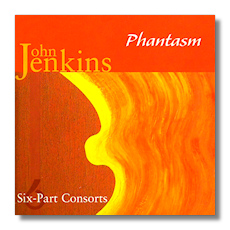
The Internet's Premier Classical Music Source
Related Links
- Jenkins Reviews
- Latest Reviews
- More Reviews
-
By Composer
-
Collections
DVD & Blu-ray
Books
Concert Reviews
Articles/Interviews
Software
Audio
Search Amazon
Recommended Links
Site News
 CD Review
CD Review
John Jenkins
Six-part Consorts

- Fantasia #9 in D minor
- In Nomine #1 in G minor
- Fantasia #2 in C minor
- Pavane in F minor
- Fantasia #8 in A minor
- Fantasia #4 in D minor
- Fantasia #11 in G minor
- Fantasia #3 in C minor
- Fantasia #1 in C minor
- In Nomine #2 in E minor
- Fantasia #12 in A minor
- Fantasia #5 in D minor
- Fantasia #10 in E minor
- Bell Pavane in A minor
- Fantasia #6 in D minor
- Fantasia #7 in A minor
Phantasm
AVIE AV2099
Here's another excellent CD from Phantasm presenting the six-part consorts of John Jenkins (1592-1678). We've looked favorably at Jenkins' five-part works (Avie AV2120) as having joyous, almost infectious, qualities, which Phantasm (Laurence Dreyfus (treble viol, director) Wendy Gillespie (treble viol), Jonathan Manson (tenor viol), Markku Luolajan-Mikkola (bass viol) with Emilia Benjamin (tenor viol) and Mikko Perkola (bass viol)) bring out admirably. They're on equally top form here too. These pieces, though, are obviously somewhat denser than those in four or five parts. It's to the credit of these six players that every note, every nuance, every ounce of light delight is conveyed without any sense of inflation or over-interpretation.
By the time it's thought Jenkins was working on the six-part pieces, the 1620s, lighter and less intense Italian chamber music was growing in influence. Lighter in the sense that it lacked the longer phrasing and perhaps the reflective nature of English consort music. Jenkins seems to have 'gone ahead regardless' and written music that not only draws on the English traditions of the previous half-century at least, but also music which celebrates its own rich and at times unusual harmonies, almost for their own sake. Certainly, one feels, for Jenkins' own pleasure… and that of his patrons.
What may strike you – especially if you're unfamiliar with the viol consort – is just how equally its members contribute. We rarely if ever discern accompanied melody. Counterpoint and unison control the development. There may be periods of remission and uptake. But the sound is not that of an augmented continuo while soloists expose. This is not to say that there aren't distinctions between, say, treble and tenor or bass instruments. But any 'advantage' momentarily gained by one player is always yielded to that of the others. This means that such tensions have to be handled by the players in quite a different way from that of, say, a crescendo or the preparation for a ritornello. It really is vital to aim (and Phantasm achieves) a kind of unity of exploration such that no one component dominates.
In other words, this is far from being music for amateurs, or worse – music for idle aristocrats, however well-intentioned. As Dreyfus says in his refreshingly informative liner notes, "You had better not pick up the viol if you can't hold your own." That's not Phantasm. They can – and do. What's more they do so as gifted and sensitive individual players also fully aware of the need to 'play as one' but without losing the music's particular lines and contrasting sonorities. So this is music more akin to Bach's (listen to the start of the first In Nomine, in g, for instance, tr.2) in its approach to counterpoint with an acknowledgment of the English madrigalists than like anything that Purcell or Blow, say, would write. But Jenkins is adventurousness. His almost symphonic approach to theme and texture proves this. Listen to the 'Bell pavan' in a (tr.14) and the Fantasie 3 in C (tr.8) for example. There's a controlled and rather intellectual awareness of dance… it's an unpredictability without being unduly mercurial: the Pavan in F is a good example.
So it certainly does need an approach to performance which is unusually mature and both involved, yet completely familiar with and comfortable in the broader issues of instrumental music of the period. Phantasm answers these implied calls very well indeed. Just follow them as they weave their way (not ways) throughout the changes in tempi of Fantasy 8 in A (tr.5). That's not surprising when you recall that Phantasm was founded (in 1994) in response to and acknowledgment of the great twentieth century string quartets. Trained on modern instruments, the fact that they moved to the richer sound of the viol and have since sought to explore the idea that modern listeners can derive modern pleasures in the pure sound of Baroque composers. With this set of wonderful six-part consorts, they more than prove their point.
The single CD, which also includes two of Jenkins' pavans and two In nomines, contains all the six-part consorts, recorded without any undue echo yet with just the right amount of atmosphere, in Merton College (Oxford) chapel. The musicians of Phantasm hold musicologists' positions in Europe and the United States; they also have a huge wealth of performing experience between them. It shows: here is an immensely well-conceived, planned, sequenced and executed disc of wonderfully varied, inventive and downright beautiful early-Baroque consort music which you will savor many times over before really even beginning to appreciate its intricacies and creative depths. Unhesitatingly recommended.
Copyright © 2007, Mark Sealey




















